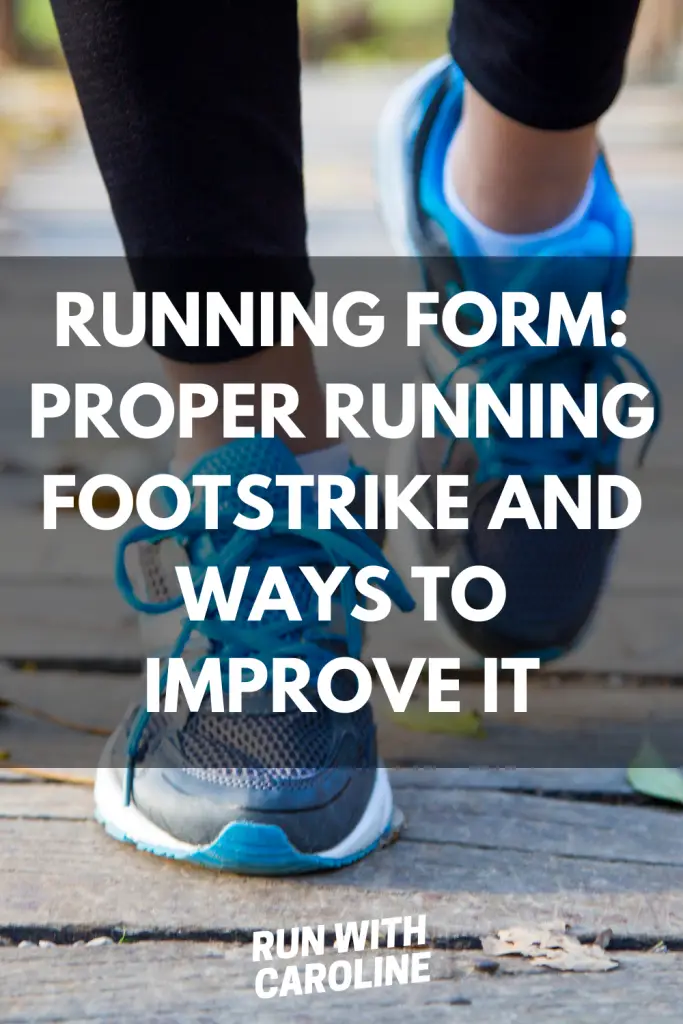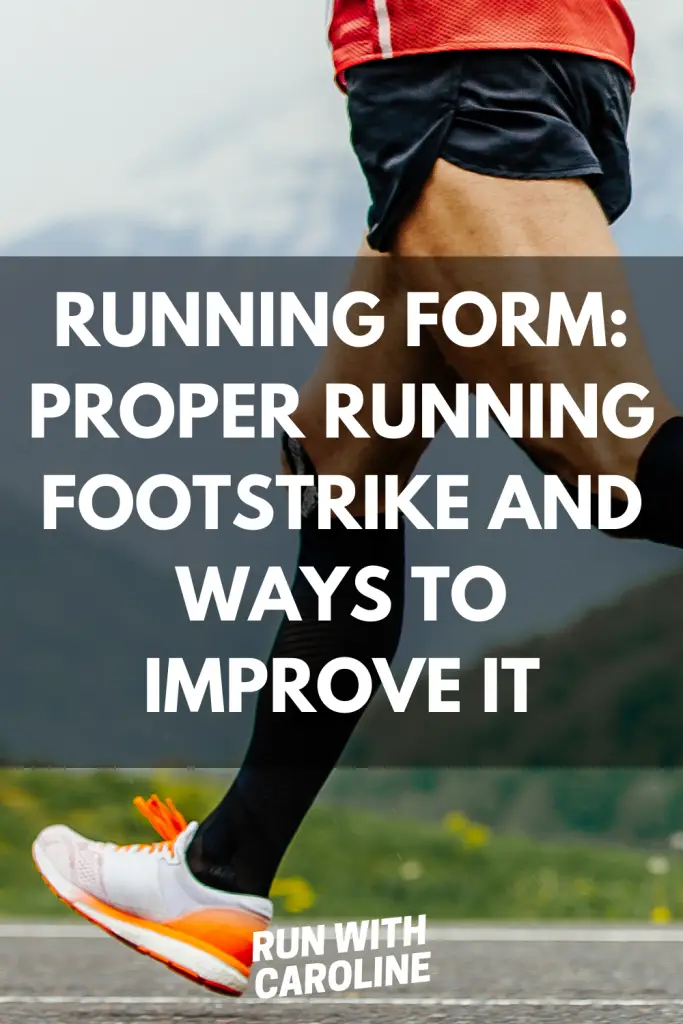Many beginner runners don’t think about proper running foot strike when they first start running.
Whilst this is ok in the short term, in the long term you may be more susceptible to injury because your foot strike and range of motion isn’t as effective as it could be.
Running sounds simple, but there are actually a lot more components that you need to think about when you start upping the weekly mileage.
Running form and all its key components especially is one of the most important but most overlooked things in running.
In this guide we’ll explore:
- What is foot strike?
- What is the best foot strike for running?
- How to fix heel strike running
- Proper running foot strike and 3 actionable ways to improve it
- 3 bonus tips to achieve proper running foot strike
Ready?
Let’s get started!

What is foot strike?
Foot strike is a key component of running form.
Running form is basically your posture whilst running. It includes all the key movements from the top of your head (your head, shoulders and chest) to your mid-line and feet.
The way your foot hits the ground (also called ‘foot strike’) is important when it comes to good running form.
Your foot strike falls into one of three categories:
- Heel foot strike
- Forefoot foot strike
- Mid-foot foot strike
According to a 2013 study of 1,991 runners, a whopping 93% of them were found to adopt a heel foot strike, with more elite runners being less likely to use a heel foot strike.
Related: The essential guide to head to toe running form and technique

What is the best foot strike angle for running?
You may be wondering what is the best foot strike for running, or the best foot strike angle running pattern.
There is no clear favourite in the running community, mainly because all three foot strike types can be used in different ways and on different terrains.
There are also some advantages to using different types of foot strike in your running as I explain more about below.
Many runners will also use all three foot strikes in one form or another throughout their running life.
This is partly due to the reasons stated above, and the fact that we all have different biomechanics (your body’s natural mechanisms).
Here are the three main foot strike patterns explained in detail:
#1 Heel foot strike
This is probably the most common foot strike. As its name suggests, this is when your heel hits the ground first before the rest of your foot.
If you sit behind a desk all day for work, it’s likely you lead with your heel first in your foot strike.
Sitting behind a desk all day can cause tight hips, so when you run you drive with your legs instead of your hips and glutes.
As a result, your stride reaches out much further than it needs to, causing your heel to hit the ground first.
Whilst this type of foot strike isn’t wrong, it isn’t great for proper running form in the long term. This is because when your heel hits the ground, it sends a shock wave through your foot and leg through to your hips.
This causes extra stress and load on your muscles and joints which over time can lead to joint pain and injuries for a lot of runners who adopt this foot strike.
Related: 7 of the best glute strengthening exercises for runners
#2 Forefoot foot strike
Forefoot foot strike is on the other end of the scale.
Also known as the ‘running on the balls of feet technique’, a forefoot foot strike is when your ball of your foot and toes hit the ground first.
It is normally characterised by a runner whose upper body that is bent forwards from the hips.
You may already use this foot strike when you run up hills or sprint at the end of a race.
As with the heel foot strike, this foot strike type isn’t incorrect, but it doesn’t lend itself to good running form. By landing on the ball of your foot and toes, you create extra tension in your calves and Achilles tendon.
You’re effectively causing tightness in them each time you take a step forward, which can cause stress and injury over time.
Related: What muscles does running work? An inside look at running performance
#3 Mid-foot foot strike
Mid-foot strike running is a happy medium.
This foot strike is characterised by the middle of the foot hitting the ground first. As a result, your weight is distributed more evenly throughout the foot and ankle.
Mid foot strike running reduces the rate at which impact forces travel up the leg. Therefore, it decreases your risk of injury.
This type of striking is considered the most natural of all the foot strikes.
Think about it:
- When you go for a walk, do you place your heel on the ground first?
- When you jog on the spot, do you land on your heel first?
Hopefully you answered ‘no’ the above questions.
This is why the mid-foot strike is the proper foot strike walking pattern and is the preferred foot strike for overground distance running as it causes the least stress on the muscles and joints in your feet and legs in the long term.
Related: 4 ways to improve running cadence

How to correct heel strike running
If someone lands with a heel foot strike, it’s probably because this is what feels most natural for them.
Of course, it’s possible to adopt a ‘heel strike midfoot’ pattern which is a combination of the heel strike and mid-foot strike patterns.
There are times, however, when your foot strike can cause you more harm than good. In these cases, it may be necessary to improve your foot strike.
For example, if you have run with a heel foot strike and experience knee pain every time you run, it may be a sign to change to a mid-foot strike so to cause less load and stress on your joints.
Read on for the best ways to improve your foot strike.
Related: The ultimate couch to half marathon training plan

Proper running foot strike and 3 actionable ways to improve it
As discussed above, there isn’t one correct or proper running foot strike.
Many runners will use a combination of all three striking patterns to run on different terrains.
It’s also a question of biomechanics.
Simply put, each runner runs and lands their feet in a way that feels natural to them.
Here are three strategies to help you improve your foot strike.
#1 Strengthen your hips and glutes
Your hips and glutes (the muscles in your buttocks) are the key parts of your body that power your leg forward when you run.
Strengthening these areas will allow you to have a more effective leg swing – drawing your leg back and cycling it forward in one fluid motion.
Some good hip strengthening exercises and glute strengthening exercises include:
- Hip bridges
- Single leg hip bridges
- Weighted hip bridges (with free weights)
- Weighted single leg hip bridges.
You’ll also want to focus on mobilising your hips and glutes. A good idea is to include exercises and stretches that increase mobility in your hips and glutes as part of your training routine.
Some effective hip mobilising exercises and stretches include:
- Deep lunges
- Pigeon holds
- Squat holds
Foam rolling is also a great way to mobilise the hips and glutes, especially if you ever feel tightness in that area.
Related: Foam rolling benefits for runners How to foam roll properly as a runner:
#2 Improve your arm swing
Proper arm swing complements your leg swing.
When you drive your legs, you’re also driving your arms.
The key is to keep your arms at a 90 degree angle, drive them back, keep them close to the sides of your body and ensure they don’t cross your body when you run.
If your arms cross your body too much, it will cause extra rotation in your spine which can cause unnecessary stress on the back.
It’s also not the most efficient way to run if your body is swaying from side to side.
Related: Proper arm swing for runners and 5 ways to improve it
#3 Increase your cadence
Proper running foot strike is closely linked with running cadence.
Your cadence is basically the total number of steps you take in a minute whilst out running. Every runner will have their own personal running cadence.
This depends on a whole host of factors, including speed, running experience and even height.
A taller runner, for example, will have a slightly slower running cadence to someone who is shorter than them as they will have a greater stride length.
If your cadence is too low, it could mean you’re taking long strides, landing heel first and effectively breaking against your forward motion.
To achieve proper running foot strike, aim to land your feet closer to your centre of gravity.
Strengthening your leg muscles through strength training and speed workouts can go a long way to improve your running cadence.
In the short term, however, monitor your cadence and see if it is impacting your run.
The sweet spot for running cadence is between 170-190 steps per minute (SPM). If your current cadence is below 170, then it may be a sign that you need to increase this.
Related: 4 ways to improve running cadence
3 bonus tips to achieve proper running foot strike
In order to achieve proper running foot strike, here are some more tips to improve your foot strike:
- Wear comfortable running shoes. Your running shoes have a large part to play in how you run. They key is to find shoes that support your feet in the right ways.
- Practice running drills. Some running drills will help you adopt a more neutral foot strike. If you’d like to adopt a mid-foot foot strike, for example, the high knees and A-skip running drills will help you do this.
- Practice, practice, practice! Changing or improving your foot strike is unlikely to happen overnight. It will take time to improve your foot strike so don’t put too much pressure on yourself.
More running form tips:
- The ultimate head to toe guide to running form and technique
- How to run properly: Running form and technique for beginners
- 4 simple tips to improve running form
- 5 things I wish I’d known before returning to running - March 3, 2024
- Running 20 minutes a day: Benefits + how to start - January 27, 2024
- How to run your first 2 hour half marathon - January 16, 2024
